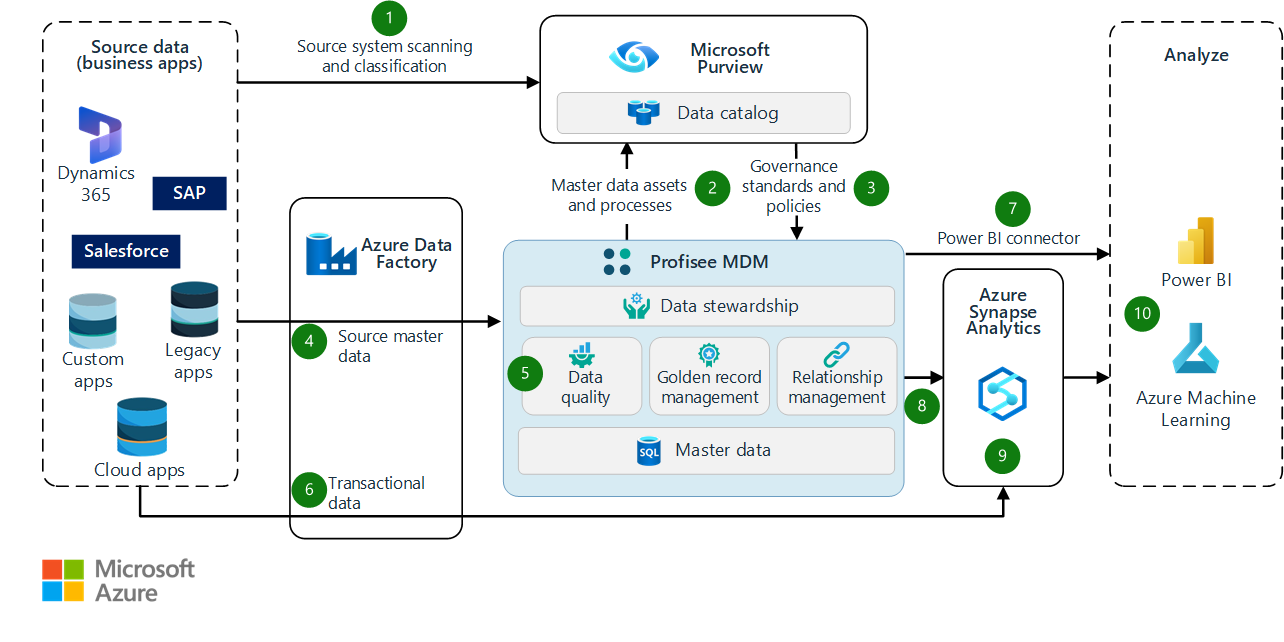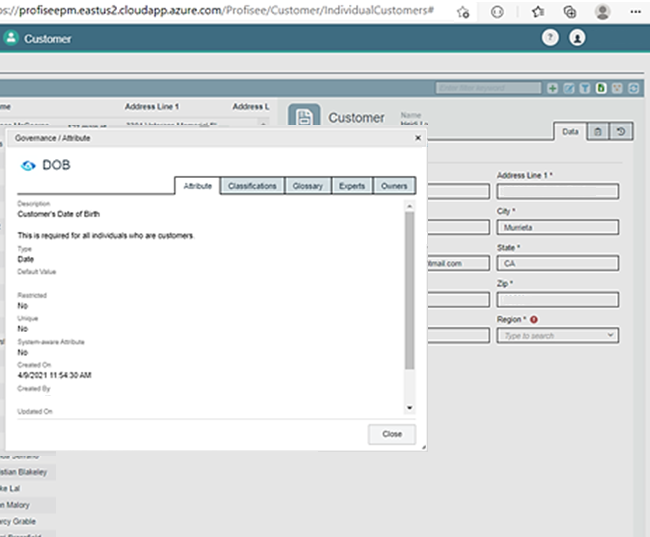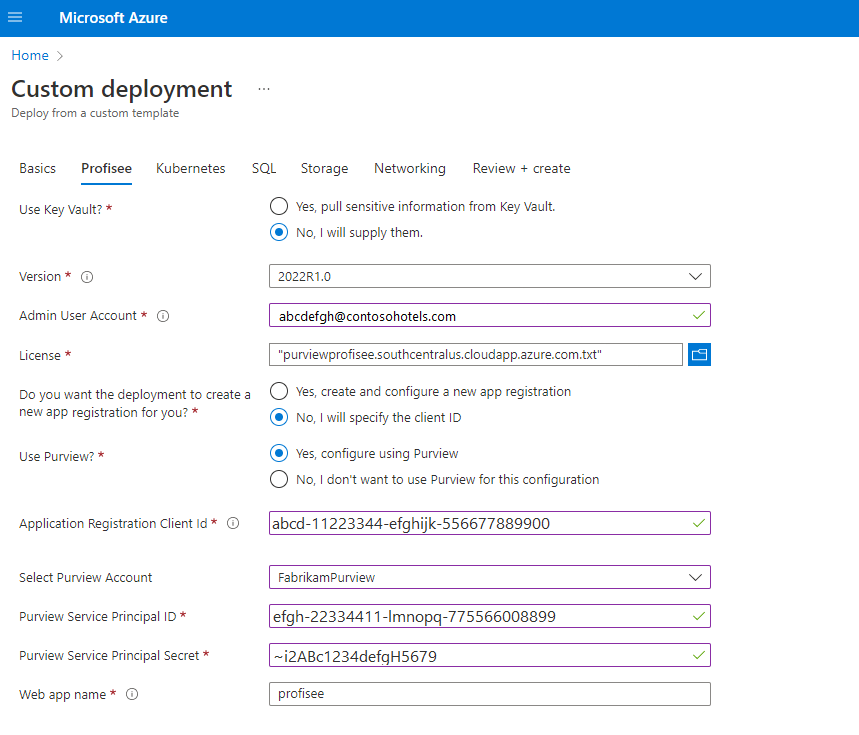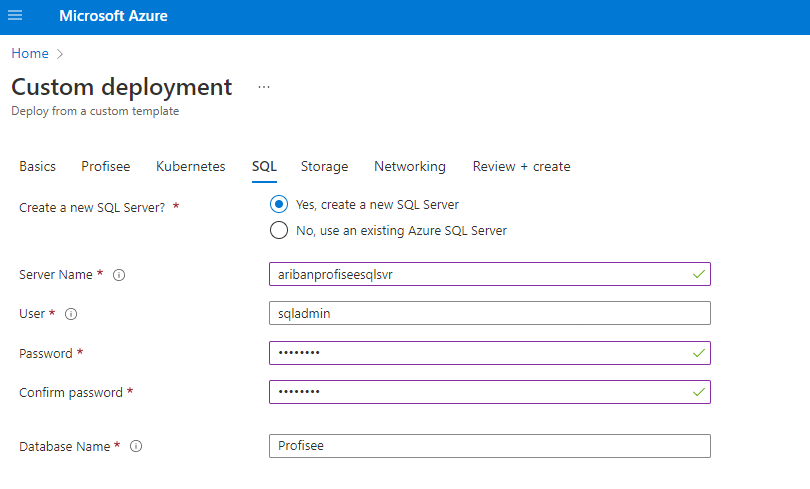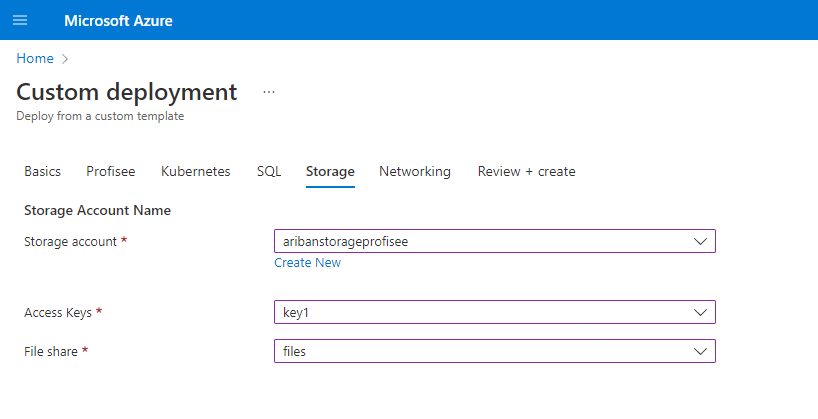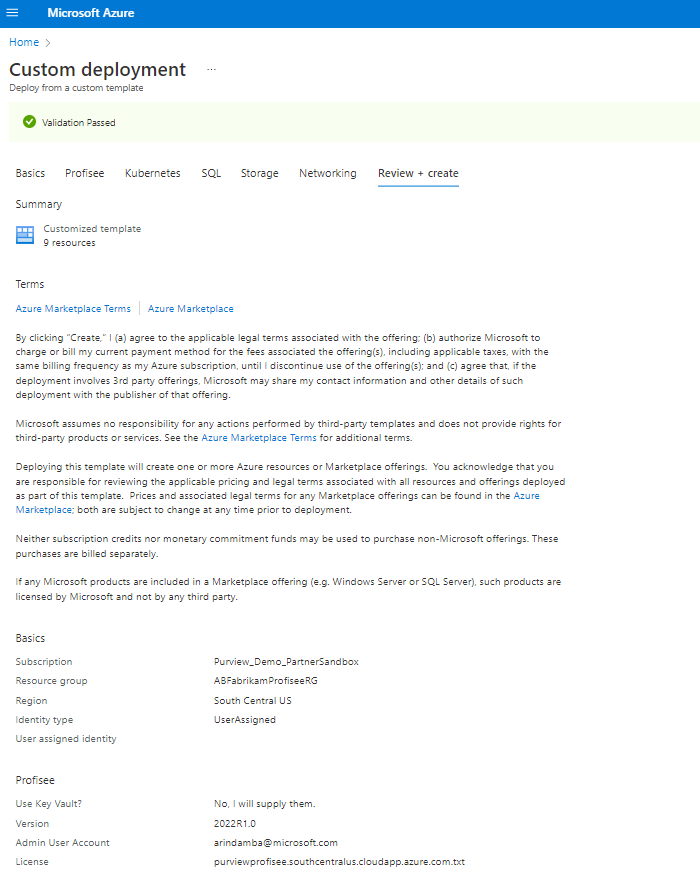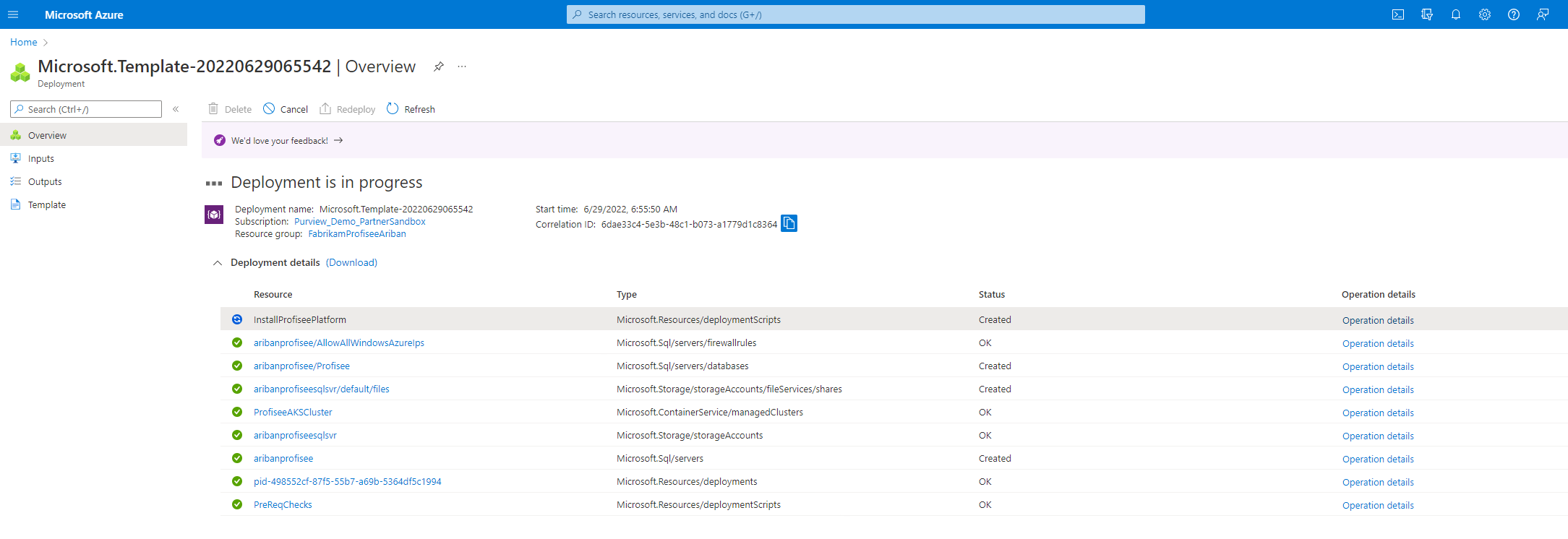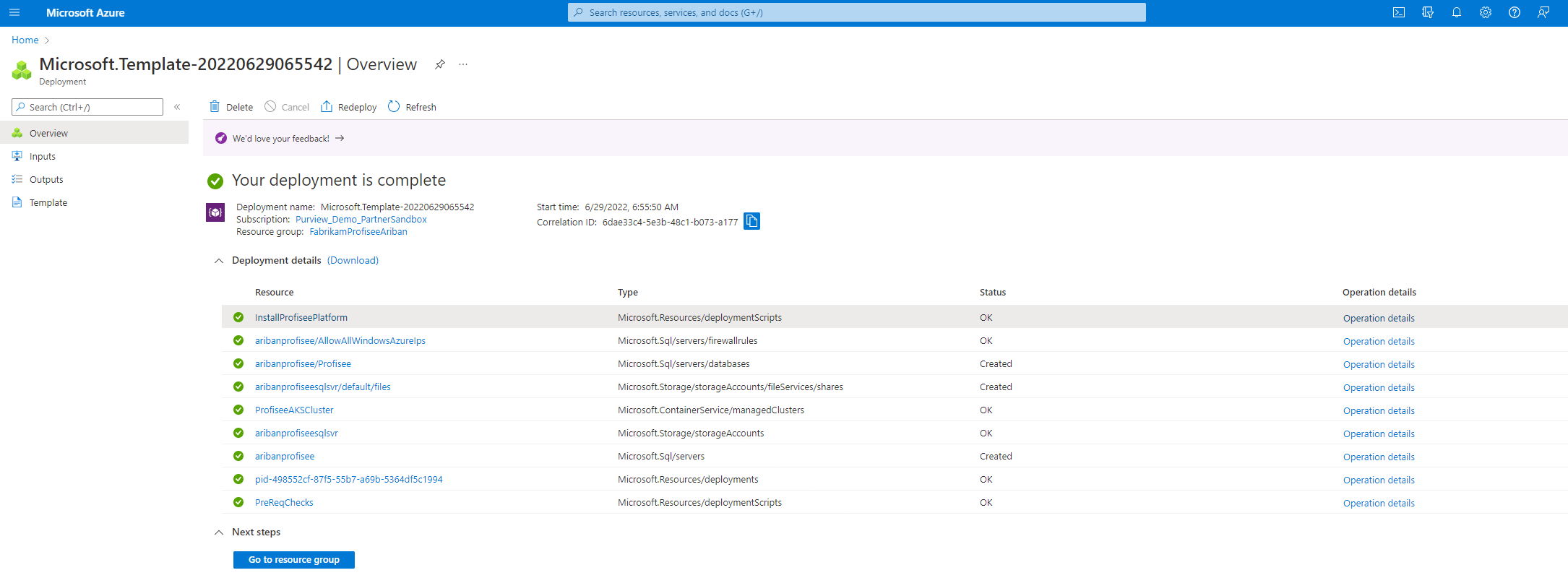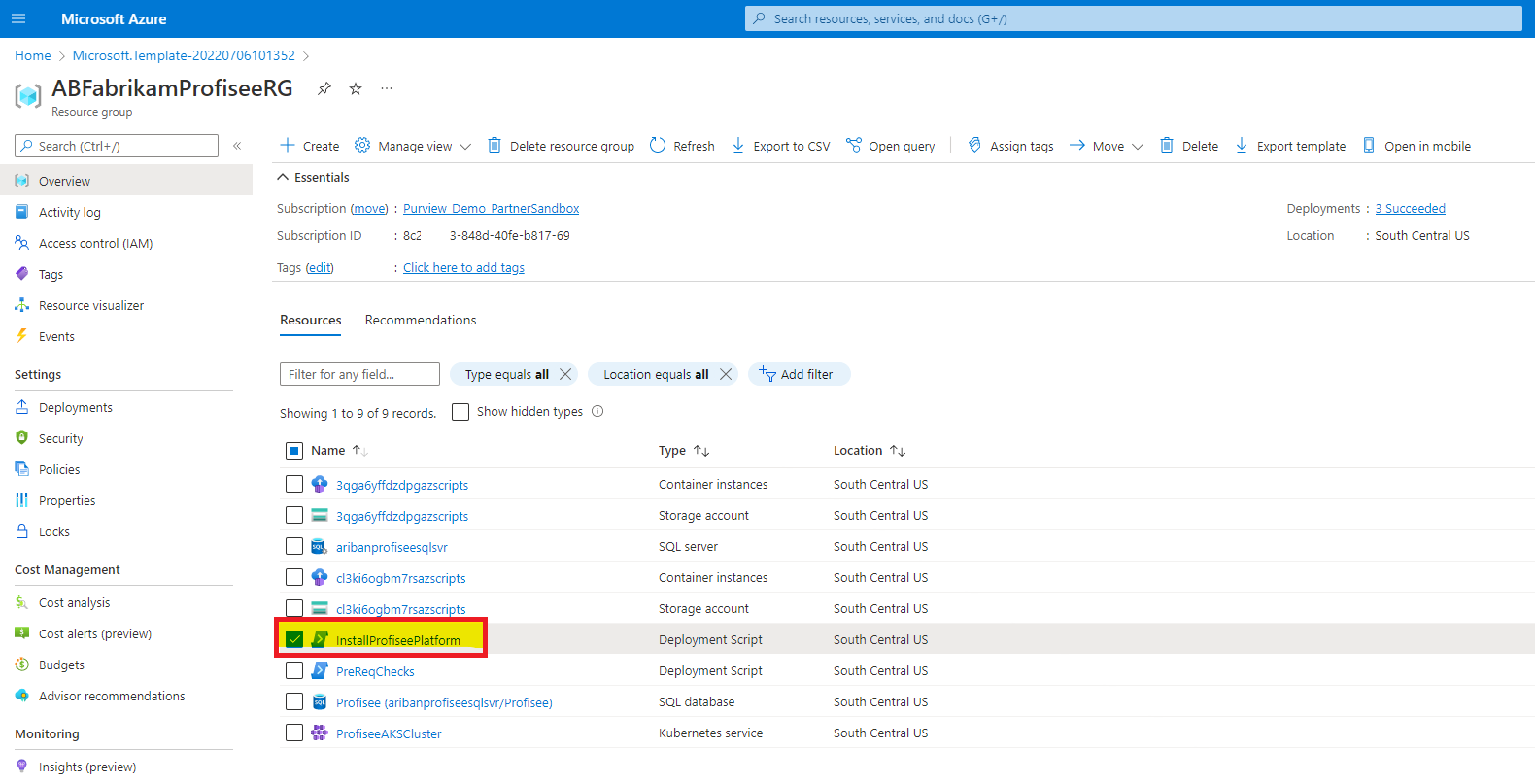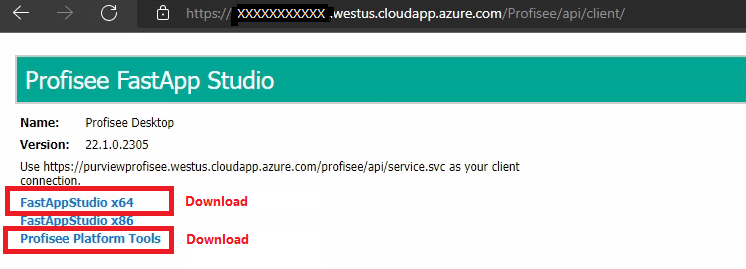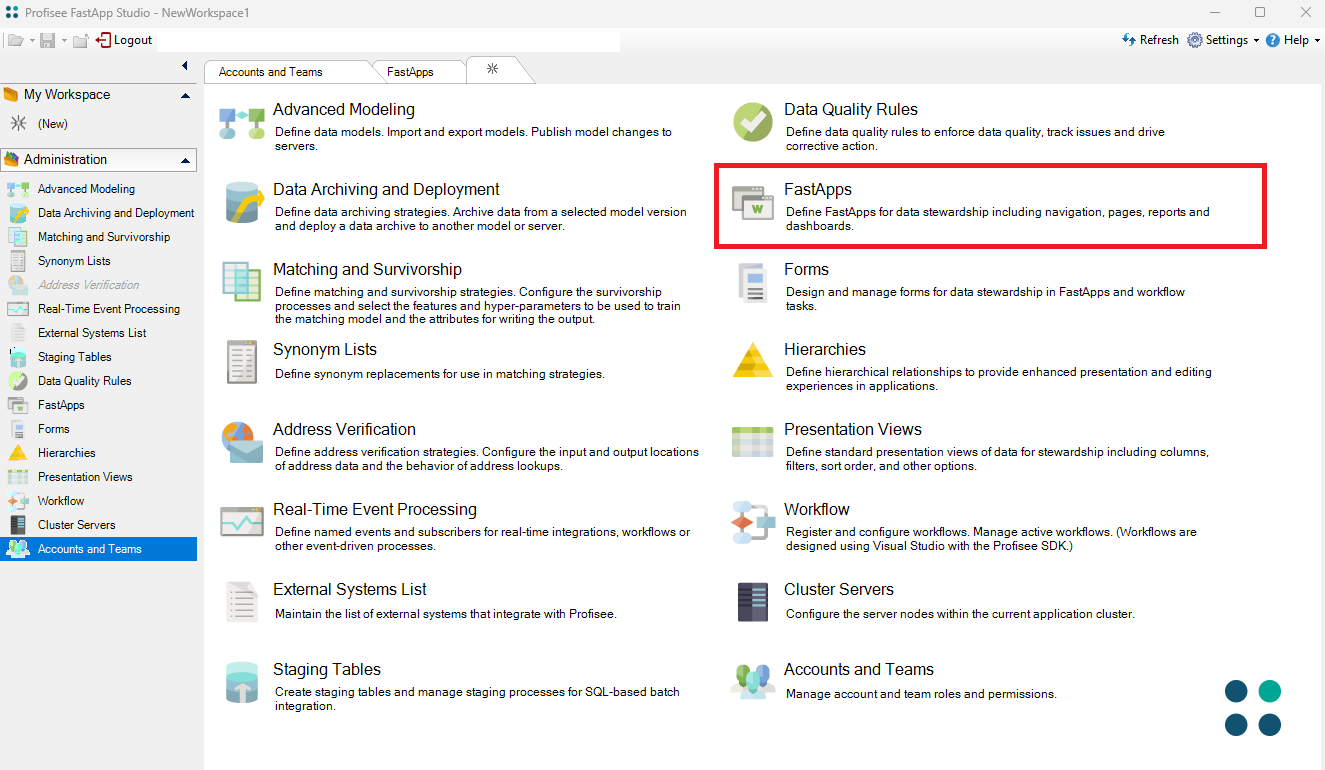Microsoft Purview and Profisee integration for master data management (MDM)
Enterprise systems can have multiple sources of master data—the common data that's shared across systems. This fact can become apparent when you catalog data sources. Examples of master data include customer, product, location, asset, and vendor data. When you use Profisee to merge, validate, and correct your master data, you can make that data effective. Specifically, you can use it to build a common trusted platform for analytics and operational improvement. By using the governance definitions, insights, and expertise that are detailed in Microsoft Purview, you can build your platform effectively.
This reference architecture presents a governance and data management solution that features Microsoft Purview and the Profisee master data management (MDM) platform. These services work together to provide a foundation of high-quality, trusted data that maximizes the business value of data in Azure. For a short video about this solution, see The power of fully integrated master data management in Azure.
Architecture
The following diagram shows the steps that you take when you develop and operate your master data solution. Think of these steps as highly iterative. As your solution evolves, you might repeat these steps and phases, sometimes automatically and sometimes manually. Whether you use automatic or manual steps depends on the changes that your master data solution, metadata, and data undergo.
Dataflow
Metadata and data flow include these steps, which are shown in the preceding figure:
Prebuilt Microsoft Purview connectors are used to build a Unified Catalog from source business applications. The connectors scan data sources and populate Unified Catalog.
The master data model is published to Microsoft Purview. Master data entities that are created in Profisee MDM are seamlessly published to Microsoft Purview. This step further populates the Unified Catalog and ensures that there's a record of this critical source of data in Microsoft Purview.
Governance standards and policies for data stewardship are used to enrich master data entity definitions. The data is enriched in Microsoft Purview with data dictionary and glossary information, ownership data, and sensitive data classifications. Any definitions and metadata that are available in Microsoft Purview are visible in real time in Profisee as guidance for the MDM data stewards.
Master data from source systems is loaded into Profisee MDM. A data integration toolset like Azure Data Factory extracts data from the source systems by using any of more than 100 prebuilt connectors or a REST gateway. Multiple streams of master data are loaded into Profisee MDM.
The master data is standardized, matched, merged, enriched, and validated according to governance rules. Other systems, like Microsoft Purview, might define data quality and governance rules. But Profisee MDM is the system that enforces these rules. Source records are matched and merged within and across source systems to create the most complete and correct record possible. Data quality rules check each record for compliance with business and technical requirements. Any record that fails validation or that returns a low probability score is subject to remediation. To remediate failed validations, a workflow process assigns records that require review to data stewards who are experts in their business data domain. After a record has been verified or corrected, it's ready to use as a golden record master.
Transactional data is loaded into a downstream analytics solution. A data integration toolset like Data Factory extracts transactional data from source systems by using any of more than 100 prebuilt connectors or a REST gateway. The toolset loads the data directly into an analytics data platform like Azure Synapse Analytics. Analysis on this raw information without the proper master golden data is subject to inaccuracy, because data overlaps, mismatches, and conflicts aren't yet resolved.
Power BI connectors provide direct access to the curated master data. Power BI users can use the master data directly in reports. A dedicated Power BI connector recognizes and enforces role-based security. It also hides various system fields to simplify use.
High-quality, curated master data is published to a downstream analytics solution. If master data records have been merged into a single golden record, parent-child links to the original records are preserved.
The analytics platform has a set of data that's certified in the sense that it's complete, consistent, and accurate. That data includes properly curated master data and associated transactional data. That combination forms a solid foundation of trusted data that's available for further analysis.
The high-quality master data is visualized and analyzed, and machine learning models are applied. The system delivers sound insights for driving the business.
Components
Microsoft Purview is a data governance solution that provides broad visibility into on-premises and cloud data estates. Microsoft Purview offers a combination of data discovery and classification, lineage, metadata search and discovery, and usage insights. All these features help you manage and understand data across your enterprise data landscape.
Profisee MDM is a fast and intuitive MDM platform that integrates seamlessly with Microsoft technologies and the Azure data management ecosystem.
Data Factory is a hybrid data integration service. You can use Data Factory to create, schedule, and orchestrate extract, transform, and load (ETL) and extract, load, and transform (ELT) workflows. Data Factory also offers more than 100 prebuilt connectors and a REST gateway that you can use to extract data from source systems.
Azure Synapse Analytics is a fast, flexible, and trusted cloud data warehouse that uses a massive parallel processing architecture. You can use Azure Synapse Analytics to scale, compute, and store data elastically and independently.
Power BI is a suite of business analytics tools that delivers insights throughout your organization. You can use Power BI to connect to hundreds of data sources, simplify data preparation, and drive improvised analysis. You can also produce beautiful reports and then publish them for your organization to consume on the web and on mobile devices.
Alternatives
If you don't have a dedicated MDM application, you can find some of the technical capabilities that you need to build an MDM solution in Azure:
- Data quality. When you load data into an analytics platform, you can build data quality into integration processes. For example, you can use hard-coded scripts to apply data quality transformations in a Data Factory pipeline.
- Data standardization and enrichment. Azure Maps can provide data verification and standardization for address data. You can use the standardized data in Azure Functions and Data Factory. To standardize other data, you might need to develop hard-coded scripts.
- Duplicate data management. You can use Data Factory to deduplicate rows if sufficient identifiers are available for an exact match. You likely need custom hard-coded scripts to implement the logic that's needed to merge matched rows while applying appropriate data survivorship techniques.
- Data stewardship. You can use Power Apps to quickly develop basic data stewardship solutions to manage data in Azure. You can also develop appropriate user interfaces for reviews, workflows, alerts, and validations.
In Microsoft-centric environments, Azure Synapse Analytics is preferred as an analytics service. But you can use any analytics database. Snowflake and Databricks are common choices.
Scenario details
As the amount of data that you load into Azure increases, the need to properly govern and manage that data across all your data sources, and data consumers grows. Data that seems adequate in the source system is often found to be deficient when it's shared. It might have missing or incomplete information, or duplications and conflicts. Its overall quality might be poor. What's needed is data that's complete, consistent, and accurate.
Without high-quality data in your Azure data estate, the business value of Azure is undermined, perhaps critically. The solution is to build a foundation for data governance and management that can produce and deliver a source of truth for high-quality, trusted data. Microsoft Purview and Profisee MDM work together to form this enterprise platform.
Microsoft Purview catalogs all your data sources and identifies any sensitive information and lineage. It gives the data architect a place to consider the appropriate data standards to impose on all data. Microsoft Purview focuses on governance to find, classify, and define policies and standards. The tasks of enforcing policies and standards, cataloging data sources, and remediating deficient data fall to technologies like MDM systems.
Profisee MDM is designed to accept master data from any source. Profisee MDM then matches, merges, standardizes, verifies, corrects, and synchronizes the data across systems. This process ensures that data can be properly integrated and that it meets the needs of downstream systems, such as business intelligence (BI) and machine learning applications. The integrative Profisee platform enforces governance standards across multiple data silos.
Better together
Microsoft Purview and Profisee MDM work better together. When integrated, they streamline data management tasks and ensure that all systems work to enforce the same standards. Profisee MDM publishes its master data model to Microsoft Purview, where it can participate in governance. Microsoft Purview then shares the output of governance, such as a Unified Catalog and glossary information. Profisee can review the output and enforce standards. By working jointly, Microsoft Purview and Profisee create a natural, better-together synergy that goes deeper than each independent offering.
For example, after you catalog enterprise data sources, you might determine that master data is present in multiple systems. Master data is the data that defines a domain entity. Examples of master data include customer, product, asset, location, vendor, patient, household, menu item, and ingredient data. Resolving differing definitions and matching and merging this data across systems is critical to the ability to use this data in a meaningful way. To be effective, you should merge, validate, and correct master data in Profisee MDM by using governance definitions, insights, and expertise that are detailed in Microsoft Purview. In this way, Microsoft Purview and Profisee MDM form a foundation for governance and data management, and they maximize the business value of data in Azure.
The alternative is to use whatever information you can get. But when you take this approach, you risk generating misleading results that can damage your business. When you instead use high-quality master data, you eliminate common data quality issues. Then your system delivers sound insights that you can use to drive your business, no matter which tools you use for analysis, machine learning, and visualization. Well-curated master data is a key aspect of building a solid, reliable data foundation.
When you use Profisee MDM with Microsoft Purview, you experience the following benefits:
- A common technical foundation. Profisee originated in Microsoft technologies. Profisee and Microsoft use common tools, databases, and infrastructure, which makes the Profisee solution familiar to anyone who works with Microsoft technologies. In fact, for many years, Profisee MDM was built on Microsoft Master Data Services. Now Master Data Services is nearing the end of its lifecycle, and Profisee is the premier upgrade and replacement solution.
- Developer collaboration and joint development. Profisee and Microsoft Purview developers collaborate extensively to ensure a good, complementary fit between their respective solutions. This collaboration delivers a seamless integration that meets customer needs.
- Joint sales and deployments. Profisee has more MDM deployments on Azure, and jointly with Microsoft Purview, than any other MDM vendor. You can purchase Profisee through Azure Marketplace. In fiscal year 2023, Profisee is the only MDM vendor with a top-tier Microsoft partner certification that has an infrastructure as a service (IaaS), containers as a service (CaaS), or software as a service (SaaS) offering on Azure Marketplace.
- Rapid and reliable deployment. A critical feature of all enterprise software is rapid and reliable deployment. According to the Gartner Peer Insights platform, Profisee has more implementations that take fewer than 90 days to complete than any other MDM vendor.
- Multiple domains. Profisee offers an approach to MDM that inherently uses multiple domains. There are no limitations to the number of master data domains that you can create. This design aligns well with customers who plan to modernize their data estates. A customer might start with a limited number of domains, but they ultimately benefit from maximizing their domain coverage across their whole data estate. This domain coverage is matched to their data governance coverage.
- Engineering that's designed for Azure. Profisee is engineered to be cloud native with options for SaaS and managed IaaS or CaaS deployments on Azure.
Potential use cases
For a detailed list of MDM use cases of this solution, see MDM use cases later in this article. Key MDM use cases include the following retail and manufacturing examples:
- Consolidating customer data for analytics.
- Having a 360-degree view of product data in a consistent and accessible form, such as each product's name, description, and characteristics.
- Establishing reference data to consistently augment descriptions of master data. For example, reference data includes lists of countries/regions, currencies, colors, sizes, and units of measure.
These MDM solutions also help financial organizations that rely heavily on data for critical activities, such as timely reporting.
MDM integration with Microsoft Purview
The following diagram illustrates in detail the integration of Profisee MDM in Microsoft Purview. To support this integration, the Profisee governance subsystem provides bidirectional integration with Microsoft Purview, which consists of two distinct flows:
- Solution metadata publishing occurs when your data modelers make changes to your master data model, matching strategies, and their related subartifacts. These changes are seamlessly published to Microsoft Purview as they occur. Publishing these changes syncs the metadata that's related to your master data model and solution. As a result, Unified Catalog is further populated, and Microsoft Purview has a record of this critical data source.
- Governance details are returned and provided to data stewards and business users. These details are available as the users view data, enrich data, and remediate data quality issues by using the Profisee FastApp portal.
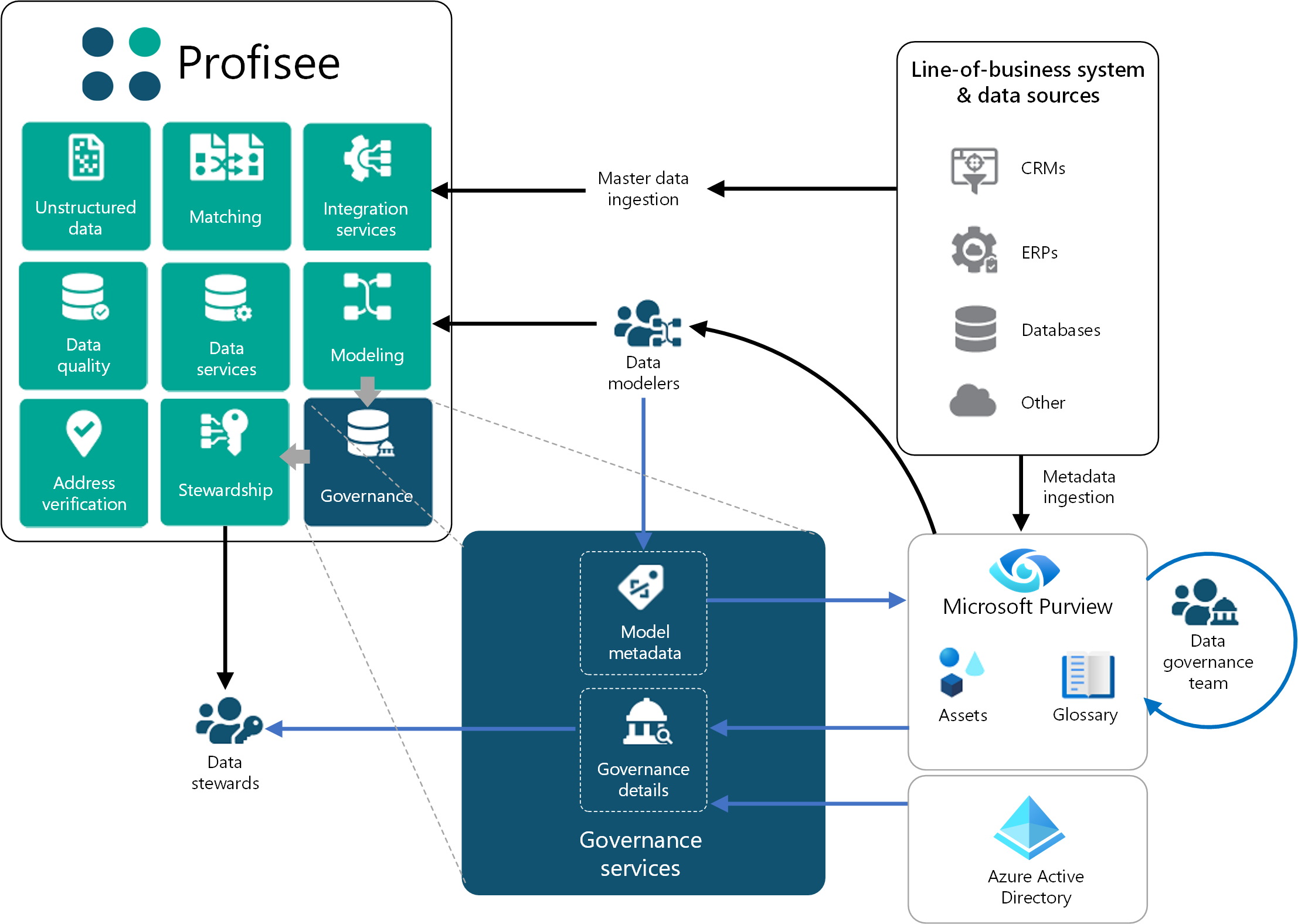
Microsoft Purview integration capabilities
The Microsoft Purview catalog and glossary can help you maximize integration.
Master data model design
One of the challenges of preparing an MDM solution is determining what constitutes master data and which data sources to use when you populate your master data model. You can use Microsoft Purview to help with this effort. You can take advantage of the ability to scan your critical data sources, and you can engage your data stewards and subject matter experts (SMEs). This way, you can enrich Unified Catalog with information that your stewards can then access, to better align your master data model with your line-of-business systems. You can reconcile conflicting terminology. This process yields a master data model that optimally reflects the terminology and definitions that you want to standardize for your business. It also avoids outdated and misleading verbiage.
The following excerpt from the broader diagram illustrates this integration use case. First, you use Microsoft Purview system scanning functions to ingest metadata from your line-of-business systems. Next, your data stewards and SMEs prepare a solid catalog and contacts. Then the data modelers who work with Profisee MDM modeling services can prepare and evolve your master data model. This work aligns with the standards that you define in Microsoft Purview.
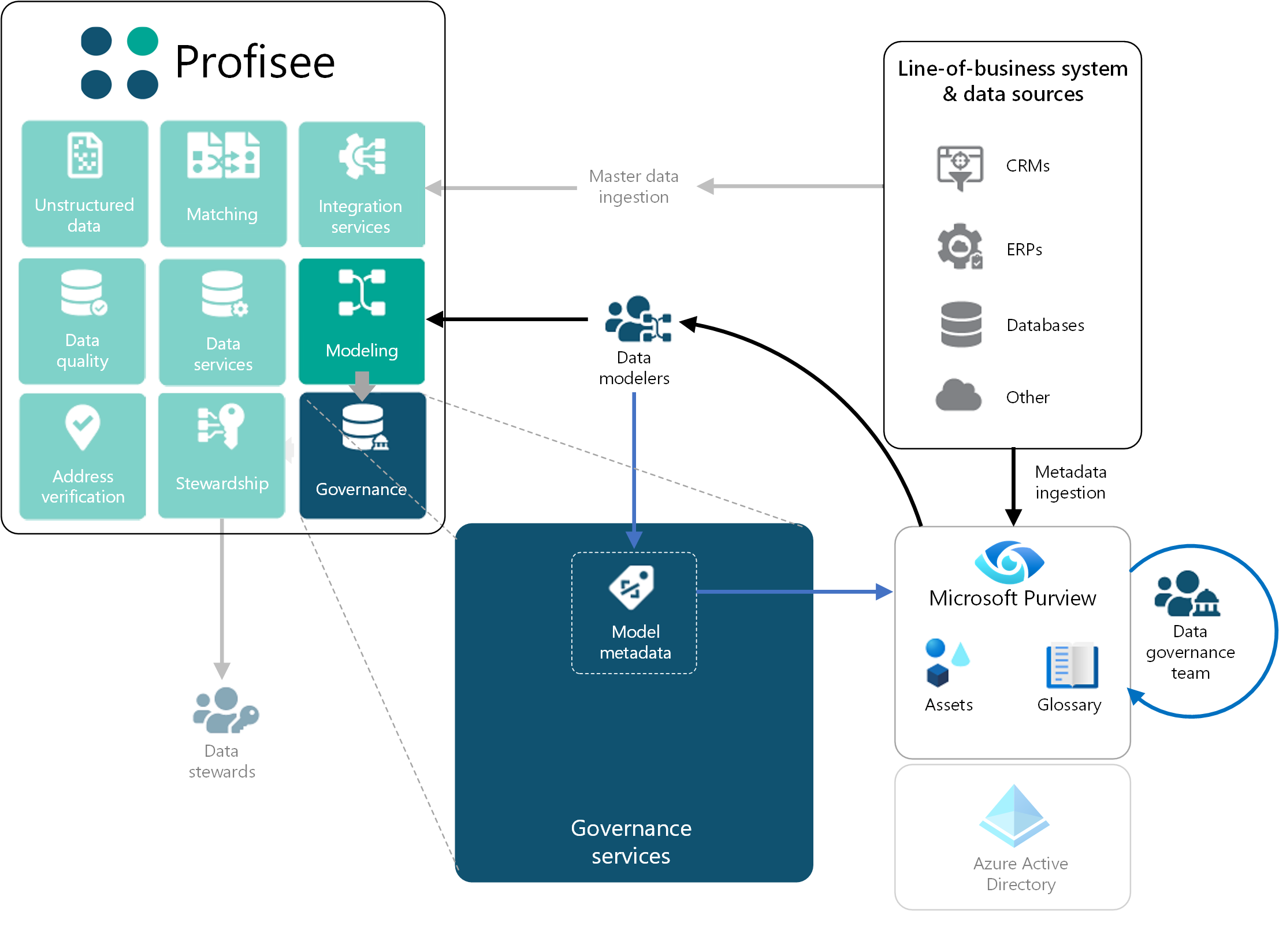
As your data stewards evolve the model, the modeling services within the Profisee MDM platform publish changes that Profisee MDM governance services receive. In turn, Profisee MDM prepares and forwards those changes to Microsoft Purview for inclusion in its updated Unified Catalog. These additions to the catalog ensure that your master data definitions are included in the broader data estate and that they can be governed and controlled in the same manner as your line-of-business system metadata. By ensuring that this information is cataloged together, you're in a better position to manage the relationships between your master data and your line-of-business system data.
Data stewardship
Large enterprises that have correspondingly complex and expansive data estates can present challenges to data stewards, who are responsible for managing and remediating issues as they arise. Key data domains can be complex, with many obscure attributes that only tenured employees who have significant institutional knowledge understand. Through the Profisee MDM integration with Microsoft Purview, you can capture this institutional knowledge within Microsoft Purview and make it available for use within Profisee MDM. As a result, you alleviate a great need for corporate data knowledge when you manage critical and time-sensitive information.
The following figure illustrates the flow of information from Microsoft Purview to the data stewards who work in the Profisee FastApp portal. The governance data service integrates with Microsoft Purview and Microsoft Entra ID. This service provides lookup functionality. FastApp portal users can use this functionality to retrieve enriched governance data about the entities and the attributes that they work with.
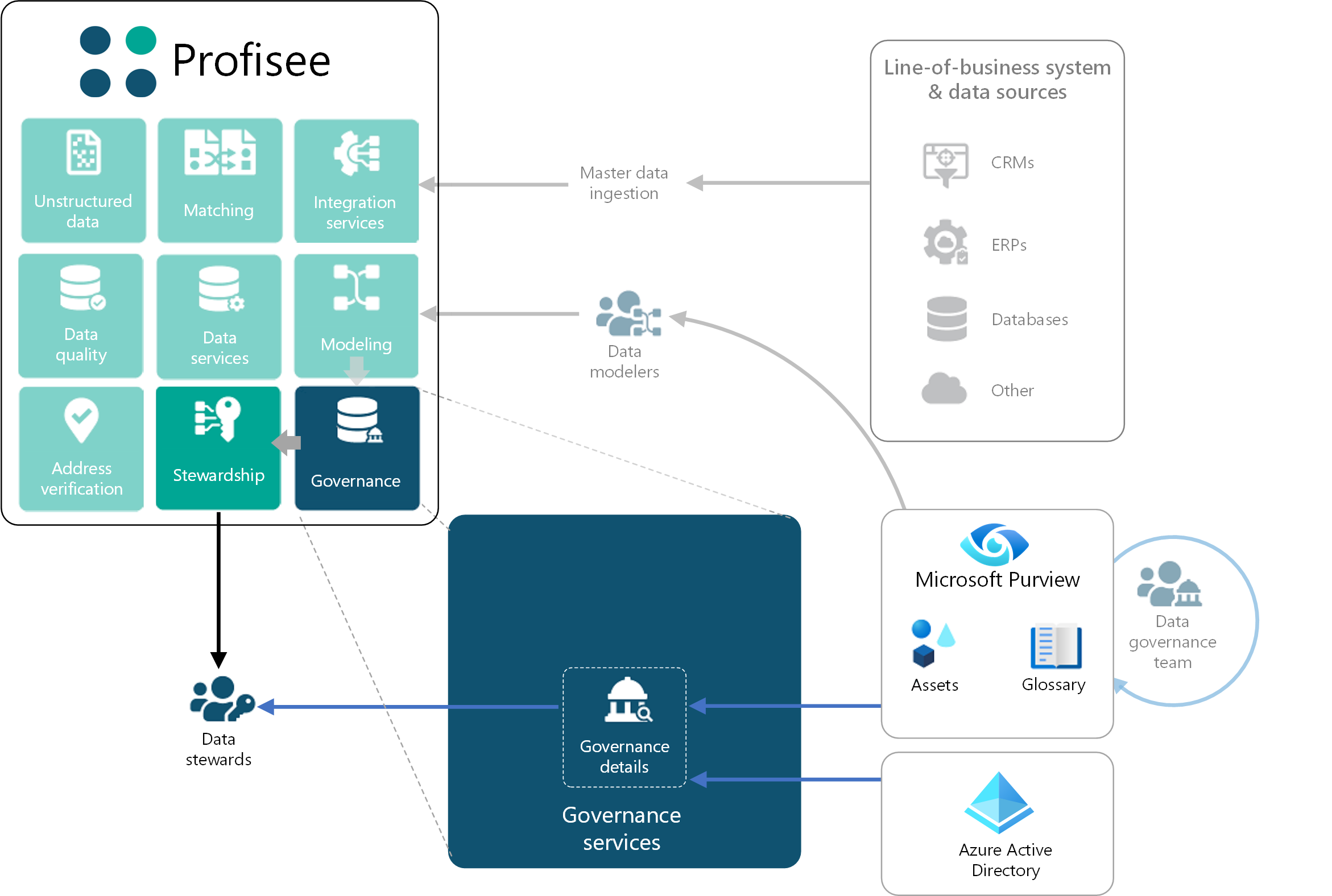
Governance services also resolve contacts that are received from Microsoft Purview to their full profile details, which are available in Microsoft Entra ID. With complete profile details, stewards can effectively collaborate with data owners and experts as they work to enhance the quality of your master data.
The Profisee MDM Governance dialog is the interface through which data stewards and users interact with governance-level details. This UI renders information that's obtained from Microsoft Purview to users. By using this information, users can review the details behind the data from which the dialog was launched. If the information that's provided in the Governance dialog is insufficient, users can go directly to the Microsoft Purview user experience.
Data stewards and business users can access three Profisee MDM data asset types via the FastApp portal:
- Profisee Instance, which provides the infrastructure properties of the specific instance of the Profisee MDM platform that the user is viewing
- Profisee Entity, which provides the properties of the master data entity (the table) that the steward or user is currently viewing
- Profisee Attribute, which provides the properties of the attribute (such as the field or column) in which the user is interested
The following figure illustrates where users who are working in the FastApp portal can view governance details for each of these asset types. You can find instance-level details on the Help menu. You can access entity details from the page zone header, which contains an entity grid. For attribute details, go to the form that's associated with the entity grid. Access the details from the labels that are associated with the attribute.
To see summary information, hover over the governance icon, such as Microsoft Purview. Select the icon to display the full governance dialog:
To go to the full Microsoft Purview user experience, select the governance icon in the dialog header. Selecting the icon takes you to Microsoft Purview in the context of the asset that you're currently viewing. You then can easily move around in Microsoft Purview based on your discovery needs.
MDM processing
The power of an MDM solution is in the details.
Data modeling
The heart of your MDM solution is the underlying data model. It represents the definition of master data within your company. Developing a master data model involves the following tasks:
- Identify elements of source data from across your systems landscape that are critical to your company's operations and central to analyzing performance.
- Enrich the model with elements that you obtain from other third-party sources that render the data more useful, accurate, and trustworthy.
- Establish clear ownership and permissions related to the elements of your data model. This practice helps ensure that you factor visibility and change management into your model's design.
Data governance provides a critical foundation of support:
- Your governance Unified Catalog, dictionary, glossary, and supporting resources are invaluable sources of information to your governance data stewards. These resources help stewards determine what to include in your master data model. They also help determine ownership and sensitive data classifications in Microsoft Purview. You can reinforce terminology in your model. Through this practice, you can establish an official lexicon for your business. By integrating terminology, your master data model can also translate any esoteric terms that are in use in various source systems to the approved language of the business.
- Third-party systems are often a source of master data that's separate and apart from your line-of-business systems. It's critical to add elements to your model to capture the information that these systems add to your data, and to reflect these sources of information back into Unified Catalog.
- You can use ownership and data access, as identified in your governance catalog, to enforce access and change management permissions within your MDM solution. As a result, you align your corporate policies and needs with the tools that you use to manage and steward your master data.
Source data load
Ideally, your disparate line-of-business systems load data into your master data model with little or no change or transformation. The goal is to have a centralized version of the data as it exists in the source system. There should be as little loss of fidelity as possible between the source system and your master data repository. By limiting the complexity of your loading process, you make lineage simpler. And when you use technology like Data Factory pipelines, your governance solution can inspect the flow. Then your solution can identify the relationships between your source system and your master data model. Specifically, your solution can extract data from source systems by using any of more than 100 prebuilt connectors and a REST gateway.
Data enrichment and standardization
After you load source data into your model, you can extend it by tapping into rich sources of third-party data. You can use these systems to improve the data that you obtain from your line-of-business systems. You can also use these systems to augment the source data with information that enhances its use for other downstream consumers. For example:
- You can use address-verification services like Bing to correct and improve source system addresses. These services can standardize and add missing information that's crucial to geo-location and mail delivery.
- Third-party information services like Dun & Bradstreet can provide general-purpose or industry-specific data. You can use this data to extend the value of your golden master record. Specifically, you might add information that was unavailable or in conflict in your disparate line-of-business systems.
Profisee's publish/subscribe infrastructure makes it easy to integrate your own third-party sources into your solution as needed.
The ability to understand the sources and meaning behind this data is as critical for third-party data as it is for your internal line-of-business systems. By integrating your master data model into your governance Unified Catalog, you can manage the relationships between internal and external sources of data while enriching your model with governance details.
Data quality validation and stewardship
After you load and enrich your data, it's important to check it for quality and adherence to standards that you establish through your governance processes. Microsoft Purview can again be a rich source of standards information. You can use Microsoft Purview to drive the data quality rules that your MDM solution enforces. Profisee MDM can also publish data quality rules as assets to your governance catalog. The rules can be subject to review and approval, which helps you provide top-down oversight of quality standards that are associated with your master data. Your rules are tied to master data entities and attributes, and those attributes can be traced back to the source system. For these reasons, you can establish the root cause of the poor data quality that originates from your line-of-business systems.
Data stewards are experts in their governance domain. As stewards address issues that your master data solution reveals, they can use the Microsoft Purview data governance catalog. The catalog helps stewards understand and resolve quality issues as they arise. Backed by the support of data owners and experts, the stewards are prepared to address data quality issues quickly and accurately.
Matching and survivorship
With enriched, high-quality source data, you're positioned to produce a golden record master that represents the most accurate information across your disparate line-of-business systems. The following figure illustrates how all the steps culminate in high-quality data that's ready to use for business analysis. At any time, you can sync this data across your data estate.
The Profisee MDM matching engine produces a golden record master as part of the survivorship process. Survivorship rules selectively populate the golden record with information that you've chosen across all your source systems.
The Profisee MDM history and audit tracking subsystem tracks changes that users make. This subsystem also tracks changes that system processes like survivorship make. Matching and survivorship make it possible to trace the flow of information from your source records to the master. Profisee MDM has a record of the source system that's responsible for a specific source record. You also know how disparate source records populate the golden record. As a result, you can achieve data lineage from your analytics back to the source data that your reports reference.
MDM use cases
Although there are numerous use cases for MDM, a few use cases cover most real-world MDM implementations. These use cases focus on a single domain, but they're unlikely to be built from only that domain. Even these focused use cases most likely involve multiple domains. In each use case, MDM meets the goal of providing a 360 degree, or unified, view of essential data types.
Customer data
Consolidating and standardizing customer data for BI analytics is the most common MDM use case. Organizations capture customer data across an increasing number of systems and applications. Duplicate customer data records result. These duplicates are located in and across applications, and they contain inconsistencies and discrepancies. The poor quality of the customer data limits the value of modern analytics solutions. Symptoms include the following challenges:
- It's hard to answer basic business questions like, "Who are our top customers?" and "How many new customers do we have?" Answering these questions requires significant manual effort.
- You have missing and inaccurate customer information, which makes it difficult to roll up or drill down into the data.
- You're unable to uniquely identify or verify a customer across organizational and system boundaries. As a result, you're unable to analyze your customer data across systems or business units.
- You have poor-quality insights from AI and machine learning due to the poor-quality input data.
Product data
Product data is often spread across multiple enterprise applications, such as enterprise resource planning (ERP), product lifecycle management (PLM), or e-commerce applications. As a result, it's challenging to understand the total catalog of products that have inconsistent definitions for properties, such as the product name, description, and characteristics. Different definitions of reference data complicate this situation. Symptoms include the following challenges:
- You're unable to support different alternative hierarchical roll-up and drill-down paths for product analytics.
- With finished goods or material inventory, you have difficulty evaluating product inventory and established vendors. You also have duplicate products, which leads to excess inventory.
- It's hard to rationalize products due to conflicting definitions. This situation leads to missing or inaccurate information in analytics.
Reference data
In the context of analytics, reference data exists as numerous lists of data. These lists are often used to further describe other sets of master data. For example, reference data includes lists of countries/regions, currencies, colors, sizes, and units of measure. Inconsistent reference data leads to obvious errors in downstream analytics. Symptoms are:
- Multiple representations of the same value. For example, the state of Georgia is listed as GA and Georgia, which makes it difficult to consistently aggregate and drill down into data.
- Difficulty streamlining data across systems due to an inability to crosswalk, or map, reference data values between systems. For example, the color red is represented by R in the ERP system and Red in the PLM system.
- Difficulty tying numbers across organizations due to differences in established reference data values that are used for data categorization.
Financial data
Financial organizations rely heavily on data for critical activities, such as monthly, quarterly, and annual reporting. Organizations that have multiple finance and accounting systems often have financial data across multiple general ledgers that needs to be consolidated to produce financial reports. MDM can provide a centralized hub to map and manage accounts, cost centers, business entities, and other financial datasets. Through the centralized hub, MDM provides a consolidated view of these datasets. Symptoms include the following challenges:
- Difficulty aggregating financial data across multiple systems into a consolidated view
- Lack of process for adding and mapping new data elements in financial systems
- Delays in producing end-of-period financial reports
Considerations
These considerations implement the pillars of the Azure Well-Architected Framework, which is a set of guiding tenets that can be used to improve the quality of a workload. For more information, see Microsoft Azure Well-Architected Framework.
Consider these factors when you choose a data management solution for your organization.
Reliability
Reliability ensures your application can meet the commitments you make to your customers. For more information, see Overview of the reliability pillar.
Profisee runs natively on Azure Kubernetes Service (AKS) and Azure SQL Database. Both services offer out-of-the-box capabilities to support high availability.
Security
Security provides assurances against deliberate attacks and the abuse of your valuable data and systems. For more information, see Overview of the security pillar.
Profisee authenticates users by using OpenID Connect, which implements an OAuth 2.0 authentication flow. Most organizations configure Profisee MDM to authenticate users against Microsoft Entra ID, which ensures that you can apply and enforce your enterprise policies for authentication.
Cost optimization
Cost optimization is about looking at ways to reduce unnecessary expenses and improve operational efficiencies. For more information, see Overview of the cost optimization pillar.
Running costs consist of a software license and Azure consumption. For more information, contact Profisee.
Performance efficiency
Performance efficiency is the ability of your workload to scale to meet the demands placed on it by users in an efficient manner. For more information, see Performance efficiency pillar overview.
Profisee MDM runs natively on AKS and SQL Database. You can configure AKS to scale Profisee MDM up, down, and across your business functions. You can deploy SQL Database in numerous configurations to balance performance, scalability, and costs.
Dynamic scaling is inherent in the cloud-native architecture of Profisee, which uses microservices and containers. If you run Profisee in your cloud tenant via Kubernetes, you can dynamically scale up and out based on your load. With the Profisee SaaS service that runs on AKS, you can configure large node pools for your pods. These pools scale dynamically based on the load on the system across the multitenant infrastructure.
For detailed information about how to deploy Profisee and Microsoft Purview on AKS, see Microsoft Purview - Profisee MDM integration.
Deploy this scenario
Profisee MDM is a packaged Kubernetes service. You can deploy Profisee MDM as a PaaS in your Azure tenant, in any other cloud tenant, or on-premises. You can also deploy Profisee MDM as a SaaS that Profisee hosts and manages.
Get the license file from Profisee by raising a support ticket on https://support.profisee.com/. The only pre-requisite for this step is your need to pre-determine the DNS resolved URL your Profisee setup on Azure. In other words, keep the DNS HOST NAME of the load balancer used in the deployment. It will be something like "[profisee_name].[region].cloudapp.azure.com". For example, DNSHOSTNAME="purviewprofisee.southcentralus.cloudapp.azure.com". Supply this DNSHOSTNAME to Profisee support when you raise the support ticket and Profisee will revert with the license file. You'll need to supply this file during the next configuration steps below.
Create a user-assigned managed identity in Azure. You must have a managed identity created to run the deployment. After the deployment is done, the managed identity can be deleted. Based on your ARM template choices, you'll need some or all of the following roles and permissions assigned to your managed identity:
- Contributor role to the resource group where AKS will be deployed. It can either be assigned directly to the resource group OR at the subscription level and down.
- DNS Zone Contributor role to the particular DNS zone where the entry will be created OR Contributor role to the DNS Zone resource group. This DNS role is needed only if updating DNS hosted in Azure.
- Application Administrator role in Microsoft Entra ID so the required permissions that are needed for the application registration can be assigned.
- Managed Identity Contributor and User Access Administrator at the subscription level. Required in order for the ARM template managed identity to be able to create a Key Vault specific managed identity that will be used by Profisee to pull the values stored in the Key Vault.
Create an application registration that will act as the login identity once Profisee is installed. It needs to be a part of the Microsoft Entra ID that will be used to sign in to Profisee. Save the Application (client) ID for use later.
- Set authentication to match the settings below:
- Support ID tokens (used for implicit and hybrid flows)
- Set the redirect URL to: https://<your-deployment-url>/profisee/auth/signin-microsoft
- Your deployment URL is the URL you'll have provided Profisee in step 1
- Set authentication to match the settings below:
Create a service principal that Microsoft Purview will use to take some actions on itself during this Profisee deployment. To create a service principal, create an application like you did in the previous step, then create an application secret. Save the Object ID for the application, and the Value of the secret you created for later use.
- Give this service principal (using the name or Object ID to locate it) Data Curator permissions on the root collection of your Microsoft Purview account.
Go to https://github.com/Profisee/kubernetes and select Microsoft Purview Azure ARM.
- The ARM template will deploy Profisee on a load balanced AKS (Azure Kubernetes Service) infrastructure using an ingress controller.
- The readme includes troubleshooting steps.
- Read all the steps and troubleshooting wiki page carefully.
Select "Deploy to Azure"
- The configurator wizard will ask for the inputs as described here - Deploying the AKS Cluster using the ARM Template
- Make sure to give the exact same RG (Resource Group) in the deployment as you gave permissions to the managed identity in Step1.
Once deployment completes, select Microsoft Purview "Go to Resource Group" and open the Profisee AKS Cluster.
Stages of a typical Microsoft Purview - Profisee deployment run
On the basics page, select the user-assigned managed identity you created earlier to deploy the resources.
For your Profisee configuration, you can have your information stored in Key Vault or supply the details during deployment.
- Choose your Profisee version, and provide your admin user account and license.
- Select to configure using Microsoft Purview.
- For the Application Registration Client ID, provide the application (client) ID for the application registration you created earlier.
- Select your Microsoft Purview account.
- Add the object ID for the service principal you created earlier.
- Add the value for the secret you created for that service principal.
- Give your web application a name.
On the Kubernetes page, you may choose an older version of Kubernetes if needed, but leave the field blank to deploy the latest version.
Tip
In most cases, leaving the version field blank is sufficient, unless there is a reason you need to deploy using an older version of Kubernetes AKS specifically.
On the SQL configuration page you can choose to deploy a new Azure SQL server, or use an existing Azure SQL Server. You'll provide login details and a database name to use for this deployment.
On the storage configuration page, you can choose to create a new storage account or use an existing one. You'll need to provide an access key and the name of an existing file share if you choose an existing account.
On the networking configuration page, you'll choose to either use the default Azure DNS or provide your own DNS host name.
Tip
Yes, use default Azure DNS is the recommended configuration. Choosing Yes, the deployer automatically creates a Let's Encrypt certificate for HTTP/TLS. If you choose No you'll need to supply various networking configuration parameters and your own HTTPS/TLS certificate.
Warning
The default Azure DNS URL (for example URL="https://purviewprofisee.southcentralus.cloudapp.azure.com/profisee") will be picked up by thr ARM template deployment wizard from the license file supplied to you by Profisee. If you intend to make changes and not use the default Azure DNS, make sure to communicate the full DNS and the fully qualified URL of the Profisee DNS to the Profisee support team so that they can re-generate and provide you the updated license file. Failure to do this will result in a malfunctioning installation of Profisee.
On the review + create page, review your details to ensure they're correct while the wizard validates your configuration. Once validation passes, select Create.
It will take around 45-50 Minutes for deployment to complete installing Profisee. During the deployment, you'll see the aspects that are in progress, and can refresh the page to review progress. The deployment will show as complete when all is finished. Completion of "InstallProfiseePlatform" stage also indicates deployment is complete!
Once deployment is completed, open the resource group where you deployed your integration.
Under outputs, fetch the final deployment URL. The final WEBURL is what you need to paste on your browser address bar and start enjoying Profisee-Purview integration! This URL will be the same that you'd have supplied to Profisee support while obtaining the license file. Unless you chose to change the URL format, it will look something like - "https://[profisee_name].[region].cloudapp.azure.com/profisee/
Populate and hydrate data to the newly installed Profisee environment by installing FastApp. Go to your Profisee deployment URL and select /Profisee/api/client. It should look something like - "https://[profisee_name].[region].cloudapp.azure.com/profisee/api/client". Select the Downloads for "Profisee FastApp Studio" utility and the "Profisee Platform Tools". Install both these tools on your local client machine.
Log in to FastApp Studio and perform the rest of the MDM Administration and configuration management for Profisee. Once you log in with the administrator email address supplied during the setup; you should be able to see the administration menu on the left pane of the Profisee FastApp Studio. Navigate to these menus and perform the rest of your MDM journey using FastApp tool. Being able to see the administration menu as seen in the image below confirms successful installation of Profisee on Azure Platform.
As a final validation step to ensure successful installation and for checking whether Profisee has been successfully connected to your Microsoft Purview instance, go to /Profisee/api/governance/health It should look something like - "https://[profisee_name].[region].cloudapp.azure.com//Profisee/api/governance/health". The output response will indicate the words "Status": "Healthy" on all the Microsoft Purview subsystems.
{
"OverallStatus": "Healthy",
"TotalCheckDuration": "0:XXXXXXX",
"DependencyHealthChecks": {
"purview_service_health_check": {
"Status": "Healthy",
"Duration": "00:00:NNNN",
"Description": "Successfully connected to Purview."
},
"governance_service_health_check": {
"Status": "Healthy",
"Duration": "00:00:NNNN",
"Description": "Purview cache loaded successfully.
Total assets: NNN; Instances: 1; Entities: NNN; Attributes: NNN; Relationships: NNN; Hierarchies: NNN"
},
"messaging_db_health_check": {
"Status": "Healthy",
"Duration": "00:00:NNNN",
"Description": null
},
"logging_db_health_check": {
"Status": "Healthy",
"Duration": "00:00:NNNN",
"Description": null
}
}
}
An output response that looks similar as the above confirms successful installation, completes all the deployment steps; and validates whether Profisee has been successfully connected to your Microsoft Purview and indicates that the two systems are able to communicate properly.
Next steps
- Understand the capabilities of the REST copy connector in Data Factory.
- Learn more about Profisee running natively in Azure.
- Learn how to deploy Profisee to Azure by using an Azure Resource Manager template (ARM template).
- View Profisee Data Factory templates.
